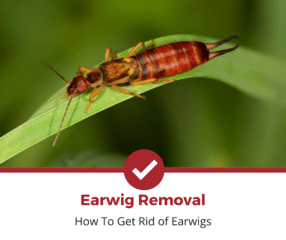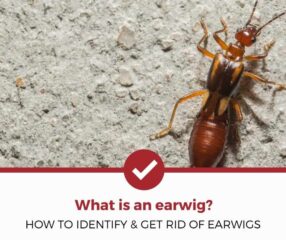Many people fear insects because of their appearance or venomous bite. However, when it comes to earwigs, a lot of the fear people have is simply because of their name. This, combined with their prominent pincers, makes the earwig one of the creepiest of the creepy-crawlies. Earwigs don’t crawl into peoples’ ears, though, and they are actually a relatively harmless pest, even if you have an infestation of them in or around your home.
Even thoughearwigs are not at all dangerous, their presence can still be a nuisance. If you are going to get rid of an earwig problem in your home, you will need to know how to identify them first. In this article, you’ll learn:
- How to Identify Earwigs
- Earwig Behavior and Habits
- What Attracts Earwigs
- How You Can Get Rid of Earwigs

Ed has been working in the pest control industry for years helping 1,000's of homeowners navigate the world of insect and rodent management. He manages Pest Strategies now helping homeowners around the world!
Best Overall
Best Service

Table Of Contents
How to Identify Earwigs
Earwigs, also known as pincher bugs, are one of the most distinctive-looking garden pests in North America. They have a very slim, long body that can grow to be up to ⅝” in length. However, some species of earwigs can get up to an inch, and some can have wings, although most of the ones you are most likely to see in or around your home do not. They will be anywhere from red to reddish-brown or dark brown, but the darker-colored ones will come off as black to the naked eye. They have very distinctive mouthparts that you will be able to notice almost right away if you happen to come across one.
The most distinctive part of an earwig is its rear pincer appendages that stick out from the back of its abdomen. These are called cerci and are used to tear up vegetation and other food that the earwig finds as it scavenges. The male earwig’s cerci will be much larger and curved while the females’ are smaller and straighter. The most common type of earwig in the United States is the European earwig, and it will have all of these defining characteristics.
Anearwig’s body is flat and shinyand has six legs that will be lighter in color than the rest of the body. The most important thing to remember if you have earwigs in your home is that while they can be intimidating and have a very creepy look, they are not dangerous to humans and their cerci are not strong enough to pierce human skin.
Earwig Behavior and Habits
Earwigs are commonly found in crawl spaces andareas that are moist and cool。由于这个原因,您可能会注意到,许多earwigs will scatter if you pick up a rock in your backyard or if you uproot a potted plant. You may also notice them in your basement or garage, where there is a lot of moisture, and they can still access the outdoors where there is vegetation for them to eat. The main danger with earwigs is their appearance, and they can be disturbing if you find them inside your home in large numbers. Luckily, they mostly relegate themselves to the dark places in the outdoors and are much more likely to be found in your garden or out on your back porch.
Female earwigs can lay eggs in batches of up to 90 at once. They will deposit these eggs underground in the autumn and hibernate when the winter arrives. Male earwigs die before the winter months, and when the summer comes along, the new earwigs hatch and eventually emerge from the underground nest. When the females emerge from hibernation, they feed their young by regurgitating food that they have collected, much as birds do. The nymph earwigs will molt their outer shell throughout the stages of their growth and eventually will leave the nest to go look for food themselves and learn to be scavengers.
This life cycle is precisely why you are not very likely to find earwigs in your home unless they were brought into the house in a potted plant. There is very little for them indoors in the way of their survival, so they prefer to stay outside. You are also not usually going to see earwigs during the day. They are fairly nocturnal creatures and will spend hours of daylight hiding in the dark areas around your home. When the sun sets, though, they will come out and hunt or forage for food, which they then bring back to their nests to feed their young or themselves.

Earwigs emit a pheromone in their feces that allows them to find each other, even if they get separated.
Find A Local Exterminator
What Are Earwigs Attracted To?
Earwigs are first and foremost attracted to the dark, cool corners of your yard or garage. They are always looking for areas with a lot of moisture and will be easily accessible to hide. These hiding places will usually be in the cracks and crevices around your home or potting soil in your garden. They will also be attracted to any decaying plant material or vegetation around your yard. Decaying organic matter is their main source of nutrition, but if they get the opportunity, they will also eat fresh vegetation or even other insects that they can get their pincers on.
One of the main things that earwigs are attracted to is each other. You will rarely find earwigs by themselves as they are fairly social creatures, and they tend to live together in groups. If you see one earwig around your property, the odds are good that you have a lot more somewhere close by. Earwigs emit a pheromone in their feces that allows them to find each other, even if they get separated.
What Are Earwigs Attracted To?
Earwigs are first and foremost attracted to the dark, cool corners of your yard or garage. They are always looking for areas with a lot of moisture and will be easily accessible to hide. These hiding places will usually be in the cracks and crevices around your home or potting soil in your garden. They will also be attracted to any decaying plant material or vegetation around your yard. Decaying organic matter is their main source of nutrition, but if they get the opportunity, they will also eat fresh vegetation or even other insects that they can get their pincers on.
One of the main things that earwigs are attracted to is each other. You will rarely find earwigs by themselves as they are fairly social creatures, and they tend to live together in groups. If you see one earwig around your property, the odds are good that you have a lot more somewhere close by. Earwigs emit a pheromone in their feces that allows them to find each other, even if they get separated.
Protect Your Home From Earwigs
Even though earwigs are not dangerous to humans, they can still be a nuisance based on their appearance alone. If you are dealing with a large earwig infestation and you cannot get rid of it yourself, it is best to call apest control professional。They will not only be able to help you get rid of your earwig problem, but they will also have suggestions on how you can prevent them from coming back.
Being comfortable in your home is essential, and if you are consistently coming across earwigs, you probably won’t be able to relax. Knowing how to identify these common pests can help you take the right course of action for your pest problems when it comes to getting rid of them.




